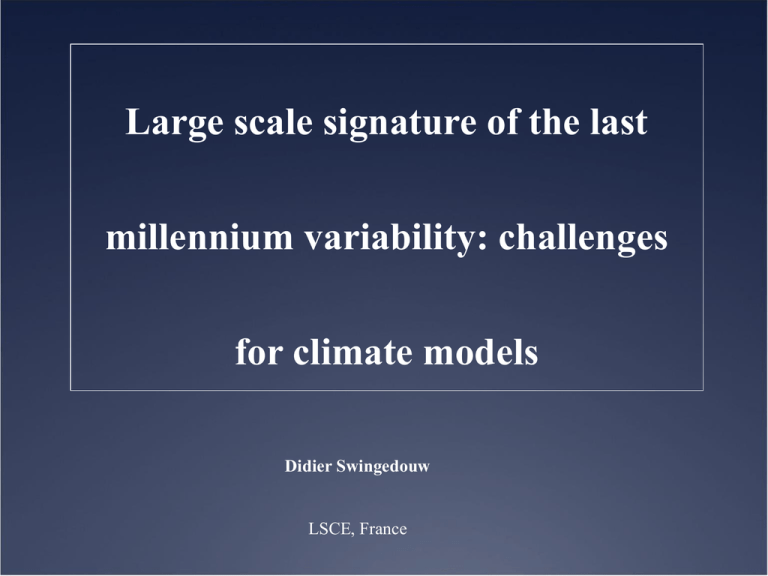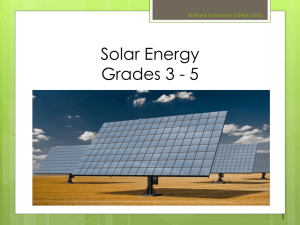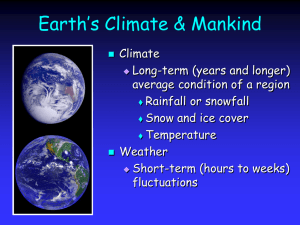Large scale signature of the last millennium variability
advertisement

Large scale signature of the last millennium variability: challenges for climate models Didier Swingedouw LSCE, France The last millennium MCA / LIA (950-1250) / (1400-1700) Nina / Nino NAO+ / NAO- Trouet et al., Science, 2009 Mann et al., Science, 2009 Mechanism of climate variability during the last millennium Solar variability Volcanic eruptions GHG variations Natural variability of the ocean (low frequency) Lots of debate! Shapiro et al., Astronomy & Astrophysics , 2011 What does climate CGCM reproduces? Tropical Pacific signal hardly found NAO signal is also very week Except in CNRMCM3? GonzalesRoucot et al. 2011 Solar forcing and NAO CNRM-CM3 millennium experiment (Swingedouw et al. 2010) NAO and solar forcing linked with more than 40 years time lag Not inconsistent with reconstructions Low NAO phase at the end of the XVIIIth century: delayed response of the Maunder Minimum(?) Solar leads NAO leads Tropical-extratropical teleconnection DJF SST, : Precipitation SLP- SLP+ Decade s SLP+ NAO in model and reconstructions NAO in model and observations Oceanic circulation changes in the Atlantic? Another potential amplifying mechanism (Lund et al., 2006) Multi-secular variability of the Gulf-Stream Related to a change in thermohaline circulation or wind forcing? Not found in many GCM. internal variability? Changes in wind stress (Cf. CNRM-CM3) Gulf stream transport reconstruction Conclusions Large scale climate variability for the last millennium in the reconstructions (Tropical Pacific, NAO, Atlantic circulation) AOGCMs hardly capture these features, raising debate Nevertheless, in CNRM-CM3, solar forcing affects the low frequency of the NAO in the CNRM-CM3 model with a 40 years lag This is due to a mechanism implying the tropical Pacific Ocean response to solar forcing and a Rossby wave teleconnection The change in tropical Pacific mean state, when solar is high, resembles la Nina State as in data from Mann et al. (2009) for the Medieval Warm Period Link with Greenland project Use data from Greenland ice core to evaluate the changes in large scale circulation as compared to simulations For this purpose: 1. Relate large scale atmospheric dynamics and Greenland climate (analogues and clustering techniques) for instrumental era 2. Evaluate the changes in these large scale regimes in the simulations 3. Evaluate any coherency with the data Thank you Solar forcing and AMOC 1. Change in NAO can modify convection in the Labrador Sea and the AMOC: Solar forcing + => NAO+ => convection Labrador + => AMOC + 1. Direct radiative effect of solar forcing can also affect the convection sites: Solar forcing + => SST+ => convection - => AMOC - Which effect is the largest? Quadfasel et al. 2005 Convection and AMOC in the model Winter Mixed layer depth in CTRL Convection sites correctly represented in this model. Impact of the NAO on the Labrador sea is also correctly represented The AMOC is of 21 Sv at 26.5°N in agreement with RAPID array Solar forcing and AMOC Principal component of 1st EOF of the AMOC is well correlated with solar forcing at lag 10 years This corresponds to a weakening of the AMOC when solar forcing increases Thermal effect (SST increase) due to radiative forcing dominates Solar leads AMOC leads Solar forcing and the subtropical gyre The 2nd EOF of the barotropic streamfunction exhibits a correlation with solar forcing This is related with changes in NAO and winds Effect on the Gulf Stream is unclear maybe due to low resolution of the ocean model Questions Can the solar forcing explain the low frequency of the last millennium climate variability (before 1850)? What are the fingerprints of solar forcing? What are the main amplifiers of this forcing? (Nino, NAO, AMOC…) Experimental design CNRM-CM3 coupled GCM (atmosphere ARPEGE T63 = 2.8°, L31 , ocean ORCA2 =2°, L31) External forcing: Solar: Crowley 2000 (0.25% changes between Maunder Minimum and present day GHG and aerosols Volcanoes (Ammann et al. 2007) Main response Northern hemisphere variations in agreement with reconstructions Strong correlation(>0.7) between solar forcing and temperature Regression on solar forcing (filtering at 13 years cut-off) Forcing of the little ice age (1/2) Regression / TSI, lag 20 years filter 40 years (17801680) Proxy Mann Solar forcing? A very slight forcing Need for amplifying mechanism: (Schindell et al., 2001) Decrease in solar irradiance leads to a negative NAO (and ozone response) 20 years delay at least for this low NAO trend => origin? Simulation ModelE Changes in stationary waves The signal is reminiscent of the Arctic Oscillation (better correlation with this index) The largest positive signal is found in the Pacific Basin Volcanoes forcing Ammann et al. (2007) : Latitude-time forcing (with largest forcing in the tropics) We isolate 20 eruptions larger than Pinatubo (in red peaks in Fig in the top) T2M signature Composite on the 20 volcanoes > Pinatubo Large cooling in the tropics Warming in Northern Europe Zonally average: we follow the forcing (1st order) : T2m : Epaisseur optique Other signatures NAO+ like-response (agreement with Otera et al. 2008 using the same atm. model) For temperature, unclear Persistence of the signature Each “bar” correspond to one event anomalies (from the 20 selected) 1 year before the event, at the beginning (year 0) and so on). Surface temperature in the tropics, SLP in the NH > 65°N (the negative anomalies SST in nino3 boxes Errors bars on the right= 2sigma







